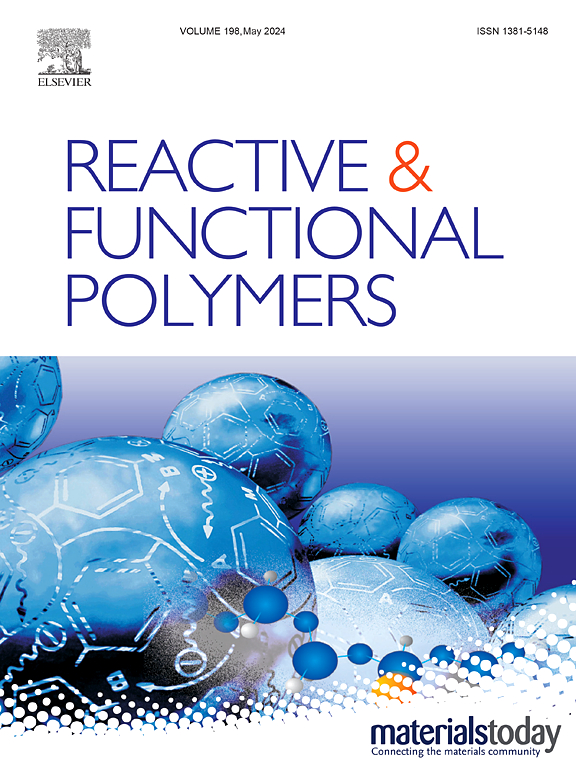Design of thermally triggered triple-shape memory ternary polymer blends for 4D printing applications
IF 4.5
3区 工程技术
Q1 CHEMISTRY, APPLIED
引用次数: 0
Abstract
4D printing represents an emerging technology that has developed from the combination of shape memory polymers (SMPs) with additive manufacturing techniques. Shape memory polymers are members of the smart materials family and have the capability to change their shape in response to a stimulus. Thermo-responsive triple-SMPs possess the capability to maintain two distinct temporary shapes and can transition between these shapes when exposed to heat. This study introduces novel ternary polymer blends incorporating ethylene vinyl acetate copolymer (EVA), maleic anhydride grafted poly(styrene-b-ethylene-butylene-b-styrene) (SEBS-MA), and poly(butyl-co-isobutyl methacrylate) (PBMA-PiBMA) polymers, which exhibit thermo-responsive triple-shape memory properties at 40 °C and 80 °C. The SEBS-MA/EVA/PBMA-PiBMA ternary blend with 30/40/30 composition showed optimal triple-shape memory performance, exhibiting 92.3 % first shape fixing, 88.0 % second shape fixing, 90.5 % first shape recovery and 100 % second shape recovery ratios. The same blend also demonstrated a dual shape memory effect at 80 °C, achieving a shape fixing ratio of 98.6 % and a shape recovery performance of 100 %. Filament of the polymer blend was produced to be used in 3D printers. Using this filament, a hinge, a daisy, a stent, and a robotic gripper were created for use in different 4D printing applications. The 4D-printed objects produced from the ternary blend filament show two-way shape recovery at 40 °C and 80 °C.

用于4D打印应用的热触发三形状记忆三元聚合物共混物的设计
4D打印代表了一种新兴技术,它是由形状记忆聚合物(SMPs)与增材制造技术相结合而发展起来的。形状记忆聚合物是智能材料家族的成员,具有根据刺激改变其形状的能力。热响应三重smp具有保持两种不同临时形状的能力,并且当暴露于热中时可以在这些形状之间转换。本研究介绍了一种新型三元聚合物共混物,包括乙烯醋酸乙烯共聚物(EVA)、马来酸酐接枝聚(苯乙烯-b-乙烯-丁烯-b-苯乙烯)(SEBS-MA)和聚(丁-co-甲基丙烯酸异丁酯)(PBMA-PiBMA)聚合物,它们在40°C和80°C下表现出热响应的三形状记忆性能。SEBS-MA/EVA/PBMA-PiBMA三元共混物的三形状记忆性能最佳,第一形状固定率为92.3%,第二形状固定率为88.0%,第一形状恢复率为90.5%,第二形状恢复率为100%。同样的共混物在80°C时也表现出双重形状记忆效应,形状固定率达到98.6%,形状恢复性能达到100%。聚合物共混物的长丝被生产出来用于3D打印机。使用这种纤维,铰链,雏菊,支架和机器人夹具被创建用于不同的4D打印应用。在40°C和80°C的温度下,由三元共混长丝制成的4d打印物体显示出双向形状恢复。
本文章由计算机程序翻译,如有差异,请以英文原文为准。
求助全文
约1分钟内获得全文
求助全文
来源期刊

Reactive & Functional Polymers
工程技术-高分子科学
CiteScore
8.90
自引率
5.90%
发文量
259
审稿时长
27 days
期刊介绍:
Reactive & Functional Polymers provides a forum to disseminate original ideas, concepts and developments in the science and technology of polymers with functional groups, which impart specific chemical reactivity or physical, chemical, structural, biological, and pharmacological functionality. The scope covers organic polymers, acting for instance as reagents, catalysts, templates, ion-exchangers, selective sorbents, chelating or antimicrobial agents, drug carriers, sensors, membranes, and hydrogels. This also includes reactive cross-linkable prepolymers and high-performance thermosetting polymers, natural or degradable polymers, conducting polymers, and porous polymers.
Original research articles must contain thorough molecular and material characterization data on synthesis of the above polymers in combination with their applications. Applications include but are not limited to catalysis, water or effluent treatment, separations and recovery, electronics and information storage, energy conversion, encapsulation, or adhesion.
 求助内容:
求助内容: 应助结果提醒方式:
应助结果提醒方式:


